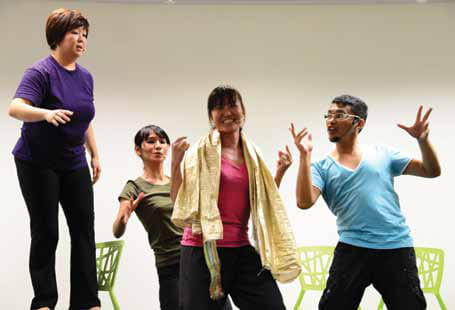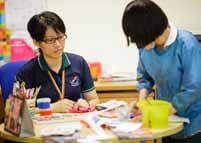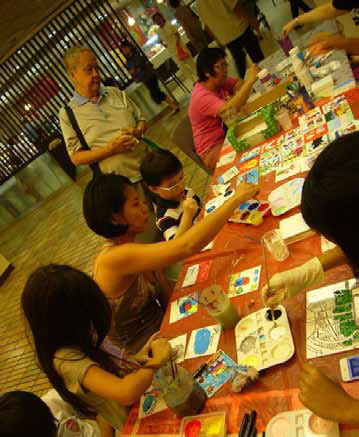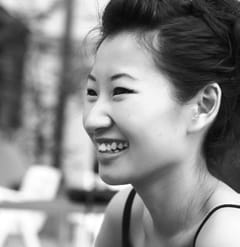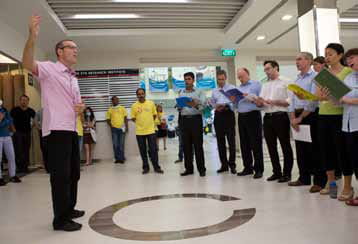Stories > Healing Touch
Healing Touch
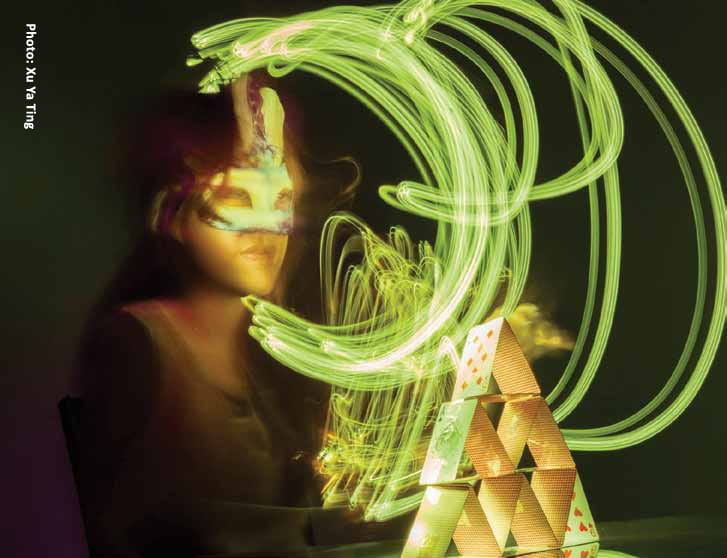
As part of the UNSEEN exhibition held at the Ai Ming Centre in Taipei last year exploring identity and self representation, this time-lapse photograph captures visually-impaired artist Xu Ya Ting, who dons a mask to symbolise ‘The Joker’ which to her, represents truth
Beyond entertaining, the arts have tremendous therapeutic power. The creative process has a positive effect on both the artist and the audience, a fact that has spurred the use of the arts as a healing modality by health professionals.
By Geri Kan
T
heatre, art, music and photography don’t just entertain; they are also a powerful means to help people heal and find new ways to manage their lives. The organisations and tools are diverse, but the goals are the same — to elevate physical, emotional and psychological well-being. The people involved in such programmes range from volunteers to full-time artists and allied health professionals.
In a cheerfully colourful room filled with art materials, 18-year-old Kelly (not her real name) fashions a bright greeting card for her friends. Every week, she attends an art therapy session at the Rainbow Centre Singapore, a non-profit organisation that helps children with special needs. There, Kelly creates whatever strikes her fancy. These could be clay figurines, smiling clowns, flowers and animals. Or she may paint pictures of her family. Then she talks about her work with her art therapist.
Above: Actors use music, voice and physical movement to improvise a skit based on the audience’s life moments at the Singapore International Foundation’s ‘Making a Difference Through International Volunteerism: A Theatrical Perspective’ event.
At Rainbow Centre, a young girl explores the world and self through paint and paper.
“Art therapy offers the children an opportunity to work through emotional obstacles, relieve stress, engage in appropriate behaviour and improve their outlook on life.”
Building Connections and Conversations
When art therapist Wan Jia Ling first met her four years ago, Kelly had epilepsy and walked with a limp. Her fingers didn’t have the physical dexterity to manipulate a paint brush well, let alone work with clay. Frustrated, she would scratch the people around her. At Kelly’s first session, she didn’t know what to do with the paints and splashed them across the table. In the intervening years, Wan has used Kelly’s painted pieces to gain insight into the teenager’s inner world. It has helped Wan elicit conversations around Kelly’s thoughts and emotions — including the teenager’s views on herself, her family and her future.
“She’s shown great cognitive and psychological improvement,” says Wan, who works with 60 to 70 students weekly. Wan was trained at Singapore’s LA SALLE College of the Arts
unlike many other certified art therapists here, who trained overseas. She adds, “Art therapy offers children an opportunity to work through emotional obstacles, relieve stress, engage in appropriate behaviour and improve their outlook on life. It can also help physically challenged children develop mastery of tools, materials and processes.”
Increasingly, community organisations, hospitals and non-profits are integrating the arts into their programmes. Music therapy helps patients manage pain; drama and theatre help disaster victims come to grips with trauma or discuss thorny issues; photography is an avenue through which the visually-impaired, who ‘see’ in their minds, get to explore their identity, and boost their confidence.
Building Trust and Cheer
Says the Association of Music Therapy’s Melanie Kwan: “We are trained to apply music purposefully toward achieving positive treatment outcomes. The training gives music therapists the skills and experience to build trust, to evaluate the usefulness of music interventions, to make adjustments, and to collaborate with other team members to provide individualised client-centred care.”
At the Singapore General Hospital (SGH), the Art Expression Wall along the corridor of Block 2 near its outpatient clinic recently featured a series of photographs by HIV positive patients. Past exhibits have included Mondrian-inspired murals by hearing impaired children and brightly-coloured tiles by patients and caregivers. This was part of the holiday arts workshop last December that depicted Singapore icons like orchids, ice-kacang and the Marina Bay Sands.
Launched in 1993 to bring cheer to patients via monthly concerts, SGH’s Arts for Health programme has expanded to provide a variety of therapeutic hands-on art activities by patients, volunteers and staff. Arts activities are also conducted at patients’ bedsides. Roving musicians serenade patients from ward to ward. Doctors make music on keyboards in the hallways. Chinese orchestras provide the live soundtrack to wushu performances. Professional bands like the Glad Stones, professional musicians such as Paris Chansons and comedians like Singapore’s Hossan Leong have all been part of SGH’s Arts for Health initiative.
To date, some 500 volunteers have spent 10,000 hours to stage over 200 concerts. SGH’s monthly concerts alone require at least 40 volunteers to take patients from wards to concert venues at the SGH open-air Quad.
Well Received
“Art is a non-threatening way to initiate communication with patients who are otherwise withdrawn due to traumatic experiences,” says SGH Community Relations Manager, Mumtaj Ibrahim. “The weekly craft sessions, for example, help break communication barriers. As volunteers and patients work on a photo frame or a bookmark together, patients learn to trust, accept help and support others. This, too, helps speed up the
rehabilitation and recovery process.”
Supported by the Shaw Foundation, SingHealth Foundation and the National Arts Council, SGH’s Arts for Health programme has been so well-received that it won the Arts Support Award in 2006 — the first hospital to do so — and again in 2007. Today, the annual arts programme includes weekly inpatient craft activities, fortnightly concerts, workshops and visual art exhibitions.
SGH is quick to emphasise the diverse yet tailored nature of Arts for Health. “Art is subjective — a string quartet performance may appeal to some and not others,” says Mumtaj. “A painting may mean something different to every person. The challenge for us is to find a suitable artistic performance or activity with mass appeal.”
Activities for children at the recent MusicFest@ SGH organised by Singapore General Hospital included painting. Above: Artist Alecia Neo works with visually-impaired people to create metaphorical photographs that convey their thoughts and experiences.
Seeing Through Photography
The words “blind” and “photography” are rarely used in the same sentence. This was not the case last November, when Singaporean artist Alecia Neo’s UNSEEN exhibition showcased work produced in collaboration with visually-imapired photographers.
Held at the Ai Ming Centre in Taipei last November after a month-long workshop, the aim was to explore identity and spark public dialogue on disability. Before each session, Alecia discussed with all six participants, born either completely or partially visually-impaired, what they’d like to photograph. The subject could be an emotion, colour, shape, texture, a person or a space. They also went on field trips in which Alecia would describe the surroundings to them. Through a technique she describes as “light painting”, she prepares participants for the photography session. Neo explains: “I felt that using light such as the torch to repeatedly trace the body and create actions is a therapeutic process. All images are created in complete darkness — symbolic of navigating in the dark whereas the light trails symbolise the participants’ journey and dreams.
“The aim is for participants to create portraits of themselves and to share their world with others. While they’re unable to see everything in the photograph, they are learning to express their points of view through their choices on the subject matter.”
Alliance Française de Singapour (AFS) Choir headed by MusicDirector Christophe Drag (in pink), who performed at the SGH Fete De La Musique.
Expressing Creativity
“Xu (one of the photographers) wanted to express the idea of the white cane being a way for her step out of her comfort zone — a way to be independent,” says Neo. “We decided this could be expressed by a circle or sphere that surrounded her. The cane also stretched beyond the circle, symbolising her desire to live independently.” Once the photographs were printed, Neo would describe the images to the photographers. Some images in the exhibit came with audio or text. In some instances, she created reliefs on their photographs “like braille.”
“It was very exciting to know that they were eager to experiment and express themselves creatively,” says Neo. Her next UNSEEN exhibition will be presented at the M1 Fringe Festival: Art & The People in 2014 at the ION Art gallery.
Conversations Around Issues
At Tapestry Playback Theatre, audiences are an integral part of the stories performed. A form of community theatre based on improvisation, Playback Theatre was developed in the US in the ‘70s. Audiences at Playback performances all over the world share a moment or story from their lives based on a theme or topic. Then three or more actors, along with a musician, spontaneously recreate that story.
Playback Theatre has been used in the aftermath of natural disasters like Hurricane Katrina to help affected populations work through their trauma, and gain perspective and hope. It has also been used in conflict and reconciliation situations, in prisons as well as with refugee organisations. In Singapore, Playback Theatre acts as a vehicle for good by promoting active ageing, community dialogue on issues of integration and migration, and in anti-bullying programmes.
“Sometimes you need to tell your story to move on from trauma. It helps when others are able to connect to your story. It can give you solidarity, strength and inspiration.”
Addressing Negative Emotions
A session begins with audience warm-ups; then the theatre practitioners share some of their own stories before getting the audience to talk about their own moments. “Generally, one story leads to another and the entire evening becomes a kind of community dialogue,” says Michael Cheng, Artistic Director of the decade-old Tapestry Playback Theatre.
Apart from acting and improvisation, actors also need strong active listening skills. “We have to work through our own stories and our own emotions in order to work with other peoples’ stories,” says Cheng. “We have grown to be more sensitive, tolerant and understanding.”
Scenarios can be unexpected and gut-wrenching. At Phnom Penh’s Healthcare Center for Children (HCC), the group led a workshop with young people who had been rescued from or were at risk of being trafficked. Cheng recalls a young girl who broke down after relating a story of sexual abuse.
“It was a powerful moment for me because the children living together had not had a platform to tell their stories,” he says. “Sometimes you need to tell your story to move on from trauma. It helps when others are able to connect to your story. It can give you solidarity, strength and inspiration.”
A Future in Music Therapy
Using art therapy as the new healing tool in healthcare and mental well-being is but a logical development. The deliberate use of different art forms like painting, theatre and even photography as a way to address psychological and emotional needs — is helpful in managing stress and coping with trauma. It’s part of the creative process of finding a path to wellness, emotional healing and recovery. Platforms like the International Art Therapy Organisation enable therapists to discuss, dialogue and even debate on issues. For all these reasons, professionals in this field see a sustainable future in art therapy, for its incredible potential to change lives.
Alecia Neo was supported by Singapore Internationale for her project ‘UNSEEN – An Extraordinary Photography Exhibition’ in which she worked with visually-impaired people in Taiwan last December.

